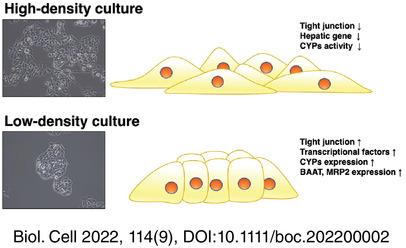An in vitro evaluation system using cultured hepatocytes is the most useful method in preclinical research, such as drug metabolism and toxicity test. Human hepatocytes should be used in an in vitro evaluation system because the expression of drug-metabolizing enzymes varies among animal species. HepG2 cells, a liver cancer-derived cell line, are widely used as a human hepatocyte model; however, their hepatic functions are generally weak.
In this study, we showed that low-density HepG2 cell culture induces hepatic function. The morphology of HepG2 cells was altered depending on the cell density at the time of seeding. Low-density cultured HepG2 cells proliferated as tightly packed colonies. The HepG2 cell colonies in low-density culture demonstrated enhanced tight junction formation. Tight junction protein gene expression levels, such as those of zonula occludens-1 (ZO-1), junctional adhesion molecule 1 (JAM), claudin, occludin, and tricellulin, increased in low-density cultured HepG2 cells. Phases I and II metabolic enzymes, phase III transporter gene expression, and CYP3A4 activity also increased in low-density cultured HepG2 cells. Occludin and tricellulin knockdown inhibited the increased hepatic function in low-density cultures. Tricellulin knockdown reduced the expression of hepatocyte nuclear factor 6 (HNF6), CCAAT/enhancer-binding protein alpha (CEBPA), and aryl hydrocarbon receptor (AHR). In addition, the expression of nuclear receptor subfamily 1 group h member 2 (NR1H2) increased in low-density cultures, canceled by occludin and tricellulin knockdown.
Our results suggest that low-density HepG2 cell cultures enhance hepatic function by promoting tight junction formation and demonstrate the importance of cell density in drug evaluation using hepatocyte cell lines.



